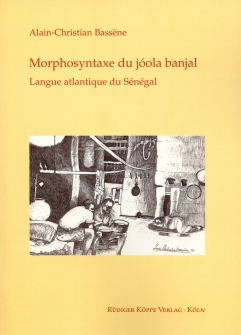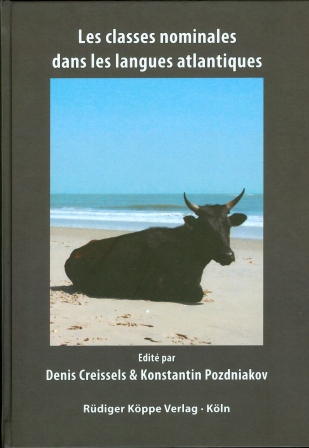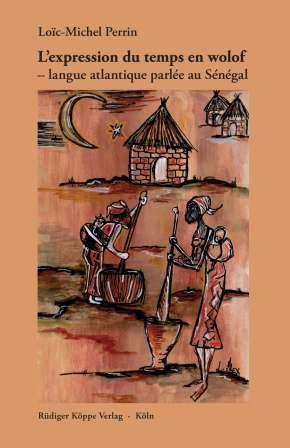


Morphosyntaxe du jóola banjal
Langue atlantique du Sénégal
Author: Alain-Christian Bassène. With a preface by: Denis Creissels. Series edited by: Wilhelm J.G. Möhlig †, Bernd Heine.
Series: GA Grammatical Analyses of African Languages Volume 32
200716 pp. Roman, 304 pp.
1 colour map, 1 b/w map, 2 colour photos, 1 graphs, 11 tables, appendix: original text with French interlinear translation, Jóola banjal-French, French-Jóola banjal wordlists
Text language(s): French
Format: 170 x 240 mm
560 g
Paperback
€ 69.80
Buy 'Morphosyntaxe du jóola banjal' as a downloadable PDF document directly from our online shop »
Order 'Morphosyntaxe du jóola banjal' as print edition »
Jóola is a group of (West) Atlantic languages spoken in Casamance (Senegal). In spite of the geographical closeness of Jóola languages and the cultural homogeneity of the communities that speak them, their degree of differentiation excludes treating them as dialectal varieties of a single language. Yet, this has been a common assumption for a long time, and therefore most of the Jóola languages are poorly documented, or not documented at all.
The present work is the first description of Jóola Banjal. It provides detailed analyses of the phonology, morphology, and syntax of the language which is spoken by approximately 7,000 people. The book should concern not only specialists of Atlantic languages but also general linguists and typologists, since it provides a presentation of Jóola Banjal morphosyntax that meets the current standards of typologically oriented language descriptions.
Résumé
Le jóola est un groupe de langues atlantiques parlées en Casamance (Sénégal). En dépit de la proximité géographique des langues jóola et de l’homogénéité culturelle des communautés qui les parlent, leur degré de différenciation ne permet pas de les traiter comme une langue unique diversifiée en plusieurs dialectes. La plupart de ces langues sont peu ou pas documentées du tout.
Ce travail constitue la première description du jóola banjal. Il présente une analyse détaillée de la phonologie, de la morphologie et de la syntaxe du jóola banjal. Il pourra satisfaire non seulement les spécialistes de langues atlantiques, mais aussi les spécialistes de linguistique générale et les typologistes dans la mesure où il présente la morphosyntaxe du jóola banjal selon les normes actuelles des descriptions linguistiques à orientation typologique.
Under these links you will find publications of the author and descriptions of further (West) Atlantic languages and cultures:
Accompanying material:
- A Dictionary of the Kisi Language
(ISBN 978-3-89645-109-5 ) - A Saafi-Saafi (Sébikotane Variety) and English // French Dictionary
(ISBN 978-3-89645-509-3 ) - Dictionnaire du balanta-ganja
(ISBN 978-3-89645-230-6 ) - Fulfulde-Studien – Fula Studies
(ISBN 978-3-89645-011-1 ) - L’expression du temps en wolof
(ISBN 978-3-89645-557-4 ) - Language Contact in Guinea
(ISBN 978-3-89645-906-0 ) - Lehrbuch des Pular
(ISBN 978-3-89645-841-4 ) - Les classes nominales dans les langues atlantiques
(ISBN 978-3-89645-565-9 ) - The Role of Wolof in Multilingual Conversations in the Casamance
(ISBN 978-3-89645-087-6 ) - Vies quotidiennes à Dakar (Sénégal) / Everyday Life in Dakar (Senegal) / Nettaliy dundin ci Ndakaaru, bis bu nekk
(ISBN 978-3-89645-285-6 )
Cross-reference:
- « Les deux amis, les tresses, et la viande » – Contes balant du Sénégal
(ISBN 978-3-89645-740-0 ) - Arbeit, Sklaverei und Erinnerung
(ISBN 978-3-89645-349-5 ) - Codeswitching in Gambia
(ISBN 978-3-927620-24-7 ) - Dictionnaire des proverbes balant
(ISBN 978-3-89645-737-0 ) - Focus and Topic in African Languages
(ISBN 978-3-89645-718-9 ) - Les Fulbe du Boobola
(ISBN 978-3-89645-301-3 ) - Lifeworlds of Young Men beyond Migration and Immobility in Pikine, Senegal
(ISBN 978-3-89645-914-5 ) - Nomades des espaces interstitiels
(ISBN 978-3-89645-252-8 ) - Temne Stories · Erzählungen der Temne · Mump me Themne
(ISBN 978-3-927620-76-6 )
Reviews
[...] B[assène]’s book – as indicated by Creissels in his preface to this book – has the intention of expanding the linguistic “database” for further typological, comparative, or general linguistic studies by documenting the system of a yet largely undocumented language. [...]
In particular, anyone interested in the [...] Jóola Banjal language, be it a typologist, a lay person, or a comparative linguist, has the luxury of consulting [...] a grammar [...] that [...] [has] been written [...] with considerable insight.
Frank Seidel in Afrika und Übersee, 91/2010, 145-150
This detailed and extensive description of Jóola Banjal (hereafter “JB”) is a welcome addition to the literature of the Atlantic languages of western West Africa. This grammar should interest not only Atlanticists and comparativists but also generalists and typologists. The author, Alain-Christian Bassène [...], remains conscious of this wider audience throughout the book and describes JB in clear, neutral language. Moreover he has benefitted from his association with the well-known Africanist and typologist Denis Creissels (there are many references to Creissels 2006), who has written a preface to the book. The grammar is clearly written, carefully researched, fully described, and plentifully exemplified – a valuable resource for all readers!
G. Tucker Childs in Journal of African Languages and Linguistics, 31/2, 2010, 275-278
| « back | Print version | [top] |
 Books
Books Audio
Audio Biographies
Biographies Series
Series Festschrifts
Festschrifts Journals
Journals